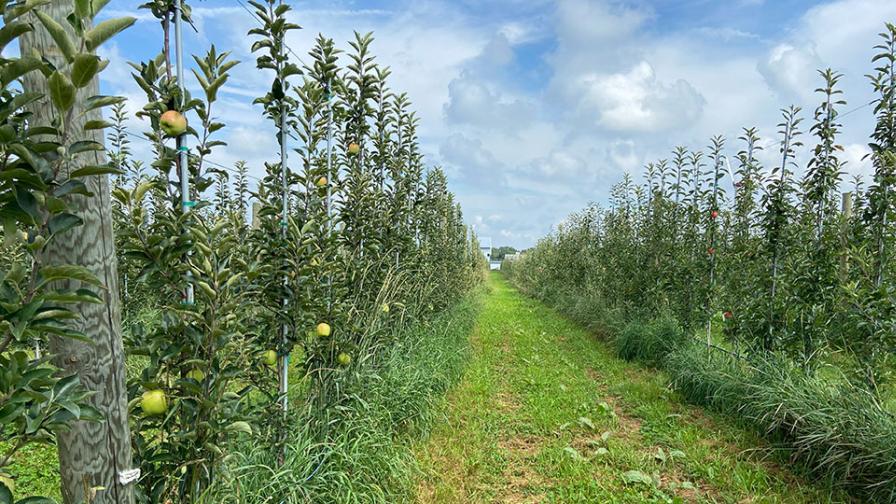Top-Working of Trees in Apple Orchards Is on the Grow

The success of top-working relies on matching an apple variety with the correct orchard system.
Photo by Thomas Skernivitz
Washington apple industry observers report they are seeing a lot more top-working of trees in the state. As the cost of a modern orchard establishment increases, prices for many varieties are in the pits, and some growers are seeking a quick changeover.
Bill Howell, Manager of the Northwest Nursery Improvement Institute in Prosser, WA, says he thinks top-working is up by as much as 20% compared with a decade ago. He doesn’t know exactly what varieties growers are transitioning to, with the exception of the Washington State University product, ‘Cosmic Crisp’. Just fewer than 700,000 trees in the state have been topped with ‘Cosmic Crisp’, though about 18 million have been planted.
Pete Van Well of Van Well Nursery in East Wenatchee, WA, suspects much of the topping is being done with the popular variety ‘Honeycrisp’.
“’Honeycrisp’ is doing well, so they’re grafting over to ‘Honeycrisp’, because it’s the one bright spot I’ve seen on the yellow (sales) sheets,” he says.
COST DIFFERENCE
The cost difference between top-working and planting is significant, Howell says. The cost of a modern trellised orchard costs about $50,000 an acre, while top-working is more like $20,000. Besides the lower initial cost, growers look to top-working for rapid conversion to a new variety, such as ‘Honeycrisp’. But top-working isn’t ideal if you don’t have the right orchard system for that variety, Howell says, or even more critical, the right rootstock.
“For example, M9 and ‘Honeycrisp’— a non-vigorous rootstock with a non-vigorous variety — not a good combination,” he says. “The top-worked variety in this case won’t fill the space.”
Van Well says growers who top-work also can avoid having to fumigate, as well as the cost of the trees.
“Nursery prices for finished trees have been going up because the minimum wage has been going up. Trees just aren’t cheap anymore,” he says. “It takes a lot of labor to make a nice nursery tree, and we’re short of labor, too.”
In addition, unless growers are experienced in grafting, they need to hire people who do have that experience, help that can be hard to find in years like this when their services are in such demand, they get completely booked. Growers also still have to pick the right variety, as well as ensuring rootstock capability, and even when top-working growers still have to pay royalties on certain varieties.
“It’s not as easy as people think it is,” he says. “It can be hard to find virus-free wood — a big concern.”
AVOID VIRUSES
Todd Snyder of C&O Nursery in Wenatchee, WA, says the potential for unknown viruses in the graft wood should be a big concern for growers.
“You can make sure to say you want clean wood,” Snyder says, “but it’s not certified and inspected.”
Having inspections and certifications are often thought of as being a pain for growers, but they do buy valuable peace of mind, Snyder says.
“You’ve got to feel more comfortable going to a nursery than to some guy who says he uses virus-free wood,” he says.
Van Well agrees, noting the nursery assumes any risk for not only viruses, but also if a scion/rootstock combination fails.
“If you don’t have experience grafting, it’s probably best to stick with nurseries,” he says. “The safest bet is the nursery tree.”
One other key factor is labor, Snyder says. Growers considering top-working often look at only the initial labor involved, not all the tasks that will face orchardists through the years.
“We feel it takes less labor to establish the orchard from a finished-trees start than all the steps involved in grafting to fruit production,” he says.
In sum, planting trees ultimately gives the grower the chance to really optimize everything. There are a lot of elements to growing an apple tree, from selecting the appropriate rootstock for the desired variety, setting the planting distances for the variety, choosing the trellis system for the variety, planting certified trees, and getting the fertility right.
“Training an orchard into whatever system you intend to utilize is easier with a finished tree,” Snyder concludes.









